Sous Vide Salmon
Published 12/14/2022
This post may contain affiliate links. Please read our disclosure policy.
Sous Vide Salmon means salmon that is always cooked to absolute perfection! Grab your sous vide and make this salmon recipe ASAP. With simple these step-by-step instructions, your sous vide salmon will be ready in no time. Dinner is served!
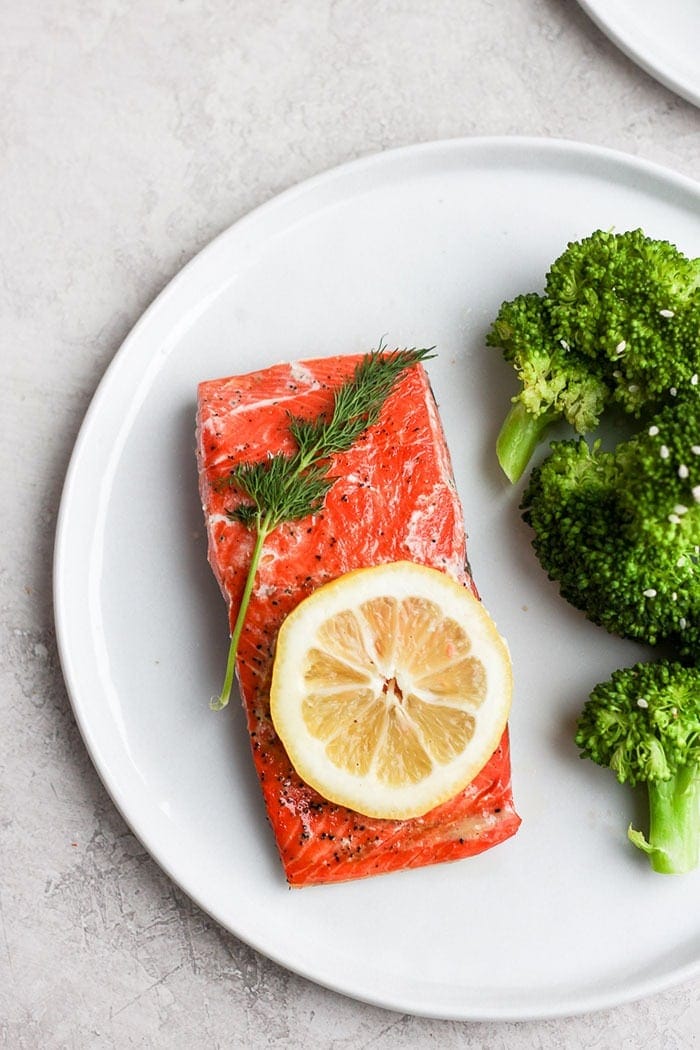
We Love Salmon!
Salmon salmon everywhere! We’re big salmon fans over here at Fit Foodie Finds, and because of that, we’ve created some great salmon recipes over the years. From breakfast frittatas to grilled salmon to our newest (this recipe!) sous vide salmon. Salmon is a great source of omega 3s, plus it’s a high protein and low-fat fish. Check out other salmon recipes here:
- Maple Ginger Baked Salmon
- Smoked Salmon Breakfast Frittata
- Lemon Butter Seared Salmon
- Foil Packed Salmon with Grilled Pineapple Salsa
- Honey Sriracha Salmon
What is Sous Vide Cooking?
If this salmon recipe is your first experience with the sous vide, have no fear! We’ll clear up any Qs you have here.
Sous vide cooking is a method of cooking where you use a regulated water bath to precisely cook food to a certain temperature. Want to cook a steak to medium rare? Good news! If you sous vide the steak, the entire steak will come out medium rare, not just the middle. The great thing about the sous vide is that whatever you are trying to cook, will come out cooked perfectly even.
Typically, meats and other food such as eggs or vegetables are vacuum-sealed in a plastic bag with the air removed and then submerged into the water bath. In this recipe’s case, we used a Stasher Bag as the vessel, which works in the exact same way.
If you are looking for the perfect, reasonable sous vide, we HIGHLY recommend the Anova Culinary 800W. It’s Smartphone-friendly and costs $99.
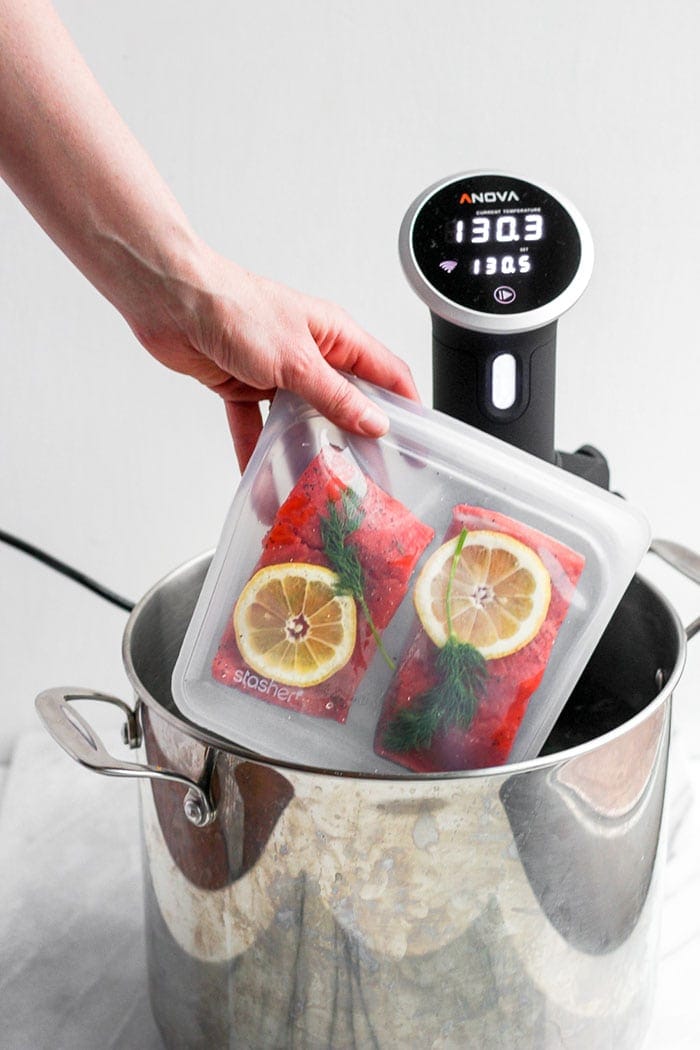
How to Make Sous Vide Salmon
Step 1: Prepare Sous Vide
First, prepare sous vide water bath by filling a large pot with water. The pot needs to be large enough to hold your salmon and the water needs to be deep enough to hit the water line on your sous vide. Next, place your sous vide into the water bath and set the temperature to 130ºF. This is the temperature setting you’ll want for medium-cooked salmon.
Step 2: Prepare Salmon
Prepare salmon by removing excess moisture from the filets. Pat the salmon filets with a paper towel to remove moisture.
Then, generously season the flesh side of the salmon filets with salt and pepper. Place a piece of fresh dill on top of each filet.
Step 3: Bag Salmon Up
Transfer each 5-oz. salmon filet into either 4 single plastic, vacuum seal or Stasher bags or 1 large plastic, vacuum seal or Stasher bag. We prefer single bags, but 1 large bag works, too!
Give each piece a salmon a nice squeeze of lemon juice before removing all air from the bag and sealing. Feel free to place a lemon slice right in the bag instead of squeezing if you’d prefer. Either way will work!
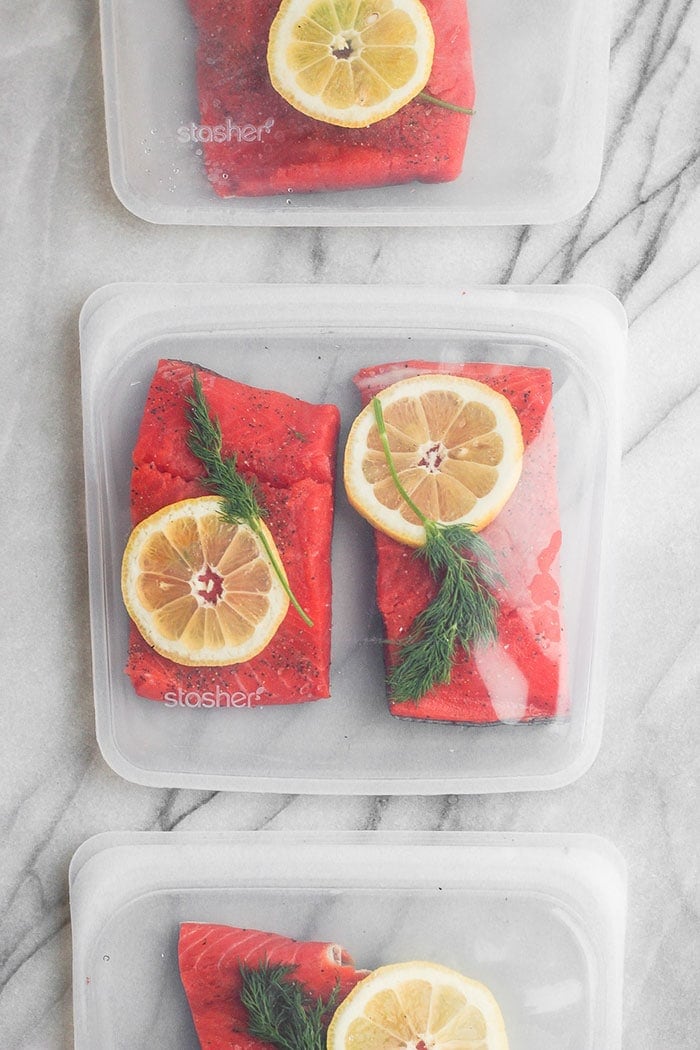
Step 4: Sous Vide That Salmon!
Place bags into the water bath and set the timer to 45 minutes. Make sure that your salmon remains submerged in the water bath.
Step 5: Broil to Perfection
Once the timer has gone off, carefully remove the bags of salmon from the water and take the salmon filets out. Place them on a baking sheet and remove the fresh dill. Then, broil them in the oven on high for 1-3 minutes (or until the top is golden brown).
If you’d prefer to finish off the salmon on the stove top, simply heat a skillet to medium/high heat and add two tablespoons of olive oil before placing the salmon filets skin-side up, and sear for 1-2 minutes (or until the top is golden brown). If you’re feeling really jazzy and have a food blow torch, torch the top of the salmon filets to golden brown.
Step 6: Enjoy!
Finally, season your salmon filets again with a little salt and pepper. The salmon should easily flake with a fork. Serve with your favorite greens and grains, and enjoy!
What to Serve with Salmon
Salmon is such a versatile main dish, but we do have some go-to side dishes that we find ourselves pairing with salmon quite often:
What are some of your favorite sides to serve with salmon?
More Sous Vide Recipes
Sous Vide Salmon
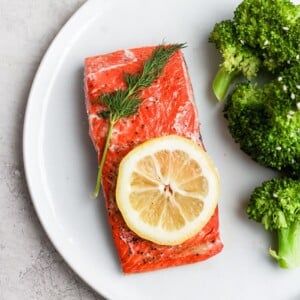
Ingredients
- 20 oz. salmon, 4 5-oz. filets
- 4 sprigs of fresh dill
- salt and pepper, to taste
- 1 medium lemon, the juice
Instructions
- First, prepare sous vide water bath by filling a large pot with water. The pot needs to be large enough to hold your salmon and the water needs to be deep enough to hit the water line on your sous vide. Next, place your sous vide into the water bath and set the temperature to 130ºF (this is for medium-cooked salmon).
- Prepare salmon by removing excess moisture from the salmon by patting the salmon filets with a paper towel.
- Generously season the flesh side of the salmon with salt and pepper. Place a piece of fresh dill on top of each filet.
- Transfer each 5-oz. salmon filet into either 4 single plastic/vacuum seal bags or 1 large plastic/vacuum seal bag. We prefer single bags, but 1 large bag works too!
- Give each piece of salmon a nice squeeze of lemon juice before removing all air from the bag and sealing.
- Place bags into the water bath and set the timer to 45 minutes.
- Once the timer has gone off, carefully remove the bags of salmon from the water and take the salmon filets out. Place them on a baking sheet and remove the fresh dill. Then, broil them in the oven on high for 1-3 minutes (or until the top is golden brown).*
- Remove salmon from the oven and season again with a little salt and pepper. Salmon should easily flake with a fork.
Tips & Notes
- Heat a large skillet pan over medium/high heat and add 2 tablespoons of olive oil. When olive oil is fragrant, set salmon down skin side up and sear for 1-2 minutes.
- Use a blow torch to brown the top of the salmon.
Watch It
Nutrition
Nutrition information is automatically calculated, so should only be used as an approximation.
Don’t forget to tag your posts on social media with the hashtag #fitfoodiefinds, we’d love to see what you’re up to!
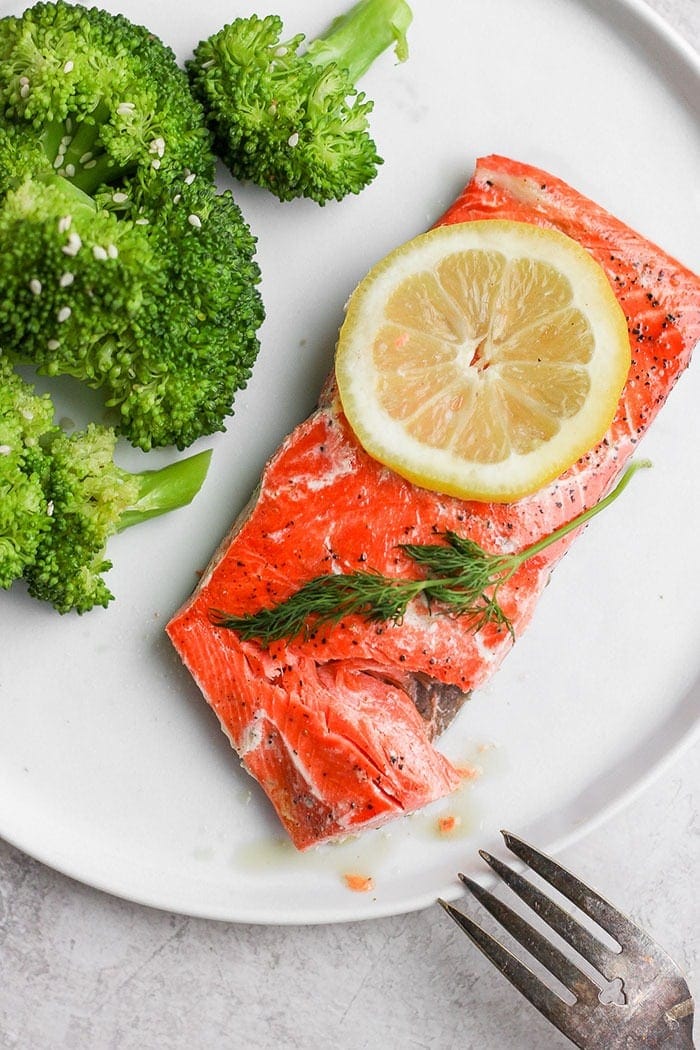
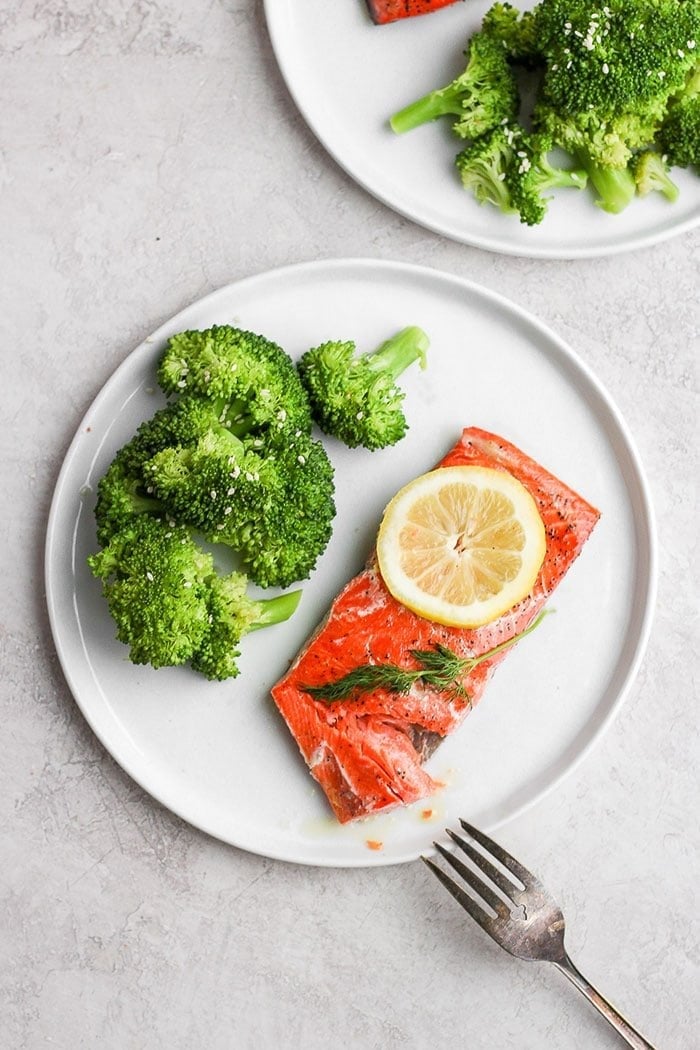
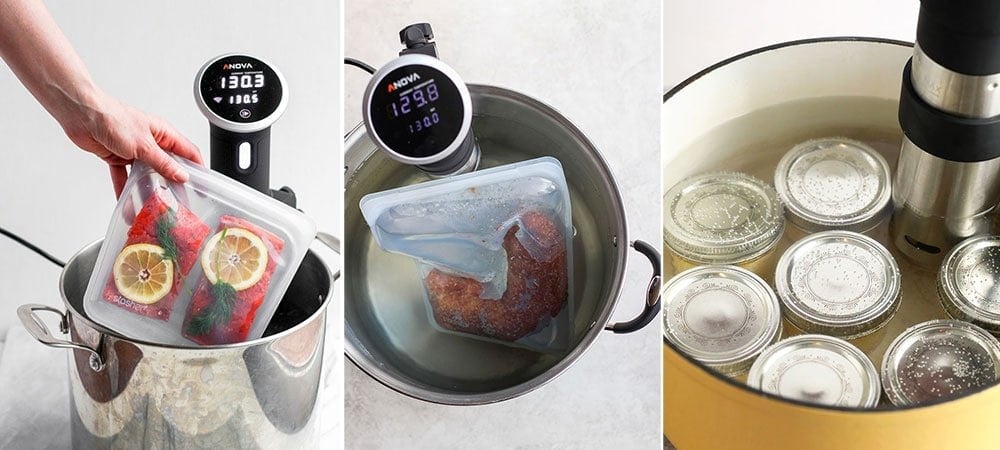
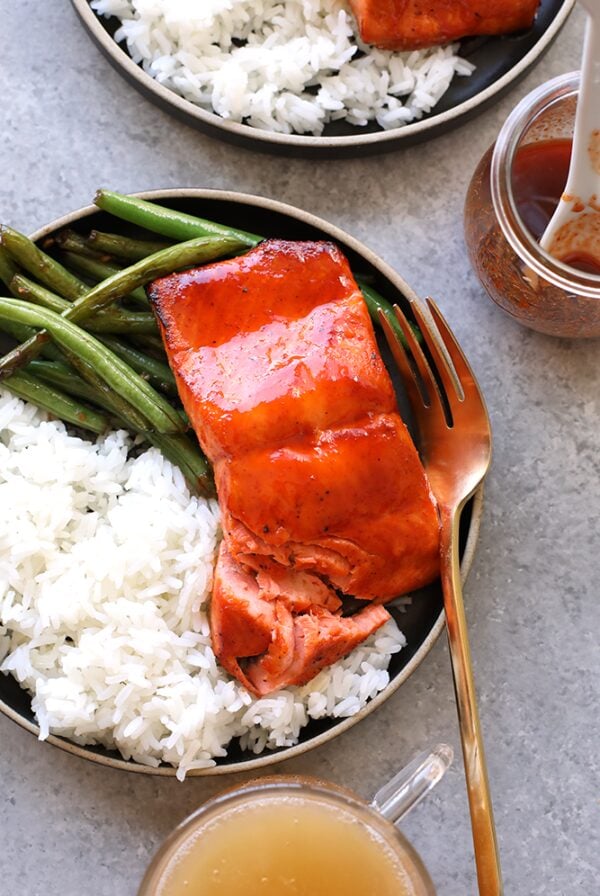
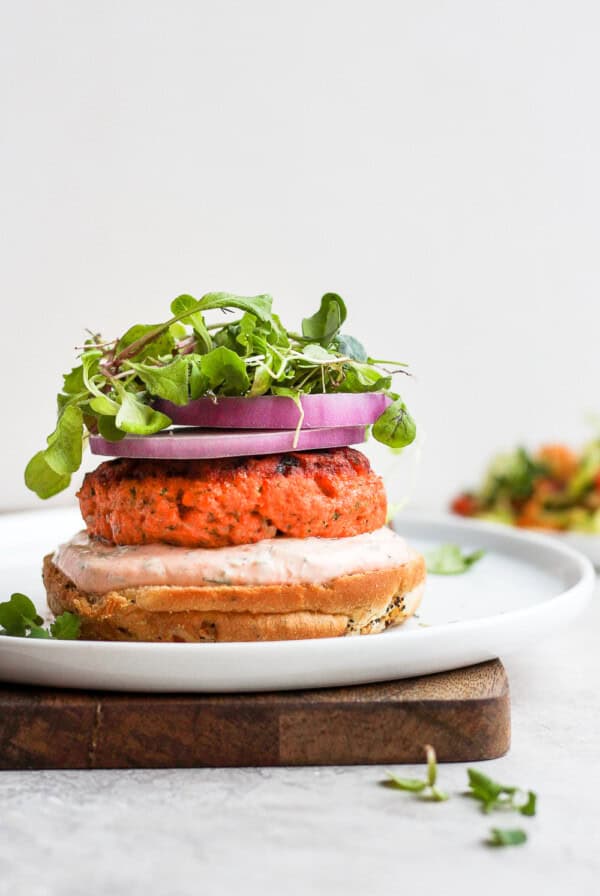
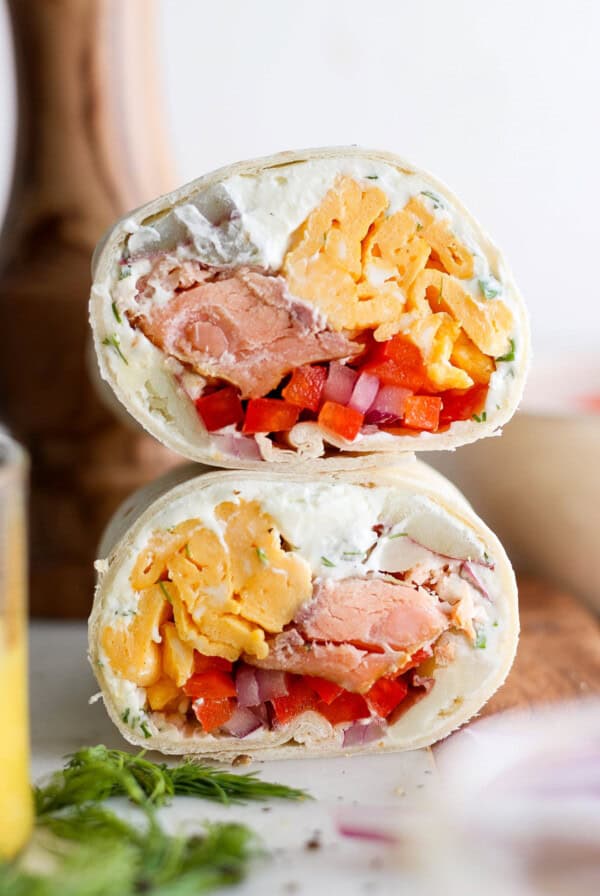
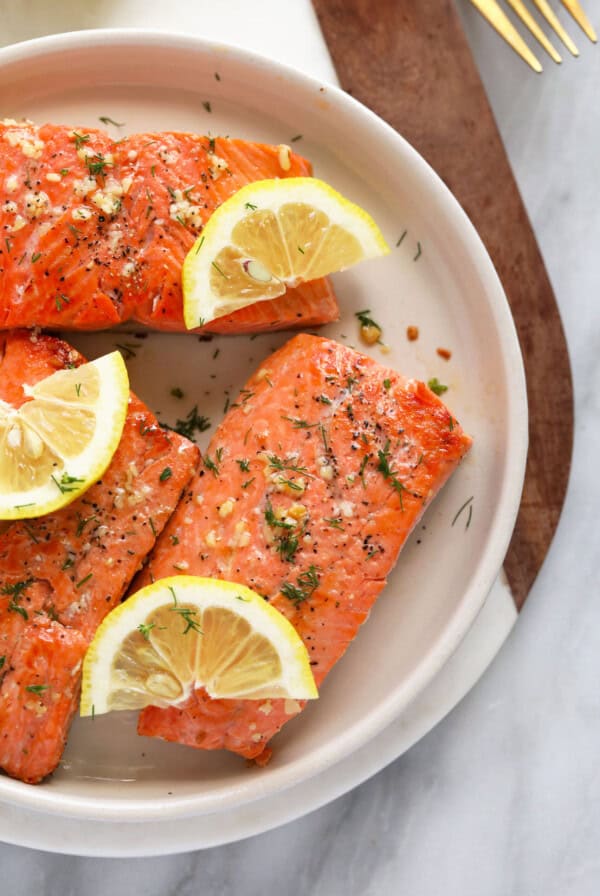






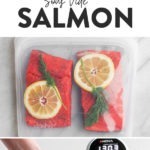

Note: Form WOULD NOT permit me to rate this recipe in stars. I’ll give it a 5 “through the back door”. Something is wrong with this feedback form.
Thank you for your thorough review! Quick question, what browser are you using?!
Blind tasting panels at America’s Test Kitchen found that tasters preferred wild salmon cooked to 120F and farmed salmon (higher fat content) cooked to 125F.
I have tried many temperatures sous vide and my wife prefers wild salmon (we never eat farmed) cooked at 120F. I do also.
130F is drier and less succulent. Went to the higher temperatures at the beginning, but as I dropped the final temperature, salmon was increasingly enjoyed more.
I actually cook sous vide to 118F, and finish with a torch. Found I always brought the temperature up too much if I pan fried or broiled it.
Don’t forget to use paper towels to dry off your salmon (or anything else), as you can’t quickly brown “wet” meat without too long a cooking period if you brown it. Sometimes I DO NOT brown it at all and just eat it as one would eat poached salmon. In this case, I cook to 120F.
I have on occasion, cut the skin from a filet, sous vide the salmon meat, and sauteed the skin separately in a hot skillet and served it with the 120F cooked salmon. Now, this, is the best of both worlds. Salmon skin is very easy to remove with a sharp knife before cooking.
Remember also that you DO NOT have to let your meat or fish “rest” when removed from the sous vide bath. The temperature will be equalized throughout the meat or fish. The internal juices DO NOT have to redistribute within the cooked flesh.
Just my observations.
I’d never thought about using a sous vide to prepare salmon, but I’m hooked on the idea. I’ve heard that using leaner salmon (Keta instead of King, for example: https://qualityseafooddelivery.com/salmon/king/) is good for sous vide. Would you have any info about that? Thanks in advance!
Hi! Either kind of salmon will work great!
Top notch!